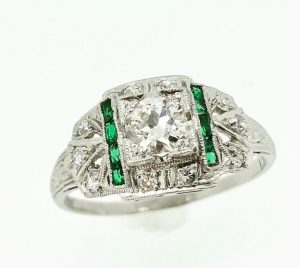WHY BUY ANTIQUE JEWELRY? The Difference Between ‘Antique’ and ‘Vintage’

You ask, “Why Buy Antique Jewelry?” Uniqueness is the simple answer. When purchasing antique vintage jewelry which is 50 years old or older, you are acquiring something from another time; something that may be rare and something that is definitely different from what you see in most jewelry stores. Consider perusing an Estate & Antique Jewelry Store, like ours. Estate Jewelry simply means previously owned. You will often come across that special Antique Jewelry find and maybe something from another time period that has specific unique characteristics.
The Difference Between ‘Antique’ and ‘Vintage’
The terms ‘antique’ and ‘vintage’ are often used more interchangeably than they should be. So, what’s the difference between antique and vintage jewellery?
Technically, a piece has to be at least a hundred years old in order to be considered an antique. However it’s not uncommon for both collectors and dealers to refer to pieces that are slightly newer than that as ‘antique’.
This is particularly common with Art Deco era pieces, like the 1920s era sapphire and diamond brooch pictured to the right, which is on the cusp of being an antique, but is not quite technically there.
In order to be considered as ‘vintage’ a piece generally has to be at least twenty years old.
The Victorian Era, c.1837-1901

A ring from the Victorian Era, c.1837-1901, could be in the shape of a serpent, crafted in gold with a center gemstone. Queen Victoria had a ring just like that with an emerald in the center as her engagement ring.
The Edwardian Era, c. 1901-1914



The Edwardian Era, c. 1901-1914, was known for its delicate workmanship in platinum, the king of metals. Platinum is known for its durability and malleability. It is the metal of preference for Master Jewelers whose skills are needed to make the finest details on a jewelry item, like milgraining, which would look like a row of tiny dots. A diamond engagement ring may have characteristics like garlands, ribbons and lace and decorated with diamonds in the mounting. Fine metal piercings might also be found in a ring from this time period
The Art Nouveau Era, c. 1890-1915

The Art Nouveau Era, c. 1890-1915, was known for its use of designs such as leaves, flowers, bugs and the shape of a woman’s face with flowing hair. Plique-a-jour was a type of see through enameling that was used in conjunction with the features described above. Yellow gold was more common during that era and it worked beautifully with stones such as aquamarine, peridot, pearls, opals and diamonds
The Art Deco Era, c. 1920-1935



The Art Deco Era, c. 1920-1935, antique engagement rings were enhanced with meticulous filigree and intricate designs. Platinum was the metal of choice. As with the Edwardian, Victorian and Art Nouveau Era, the Art Deco Era also used hand fabrication vs. casting, into the early 1930’s, to make its most delicate and complicated pieces of jewelry.
The Retro Era, c. 1935-1950

The Retro Era, c. 1935-1950, was more well-known for its jewelry crafted in rose, yellow or green gold. Rings, for instance, were oversized and gemstones that were popular during that time were diamond, aquamarine, topaz, citrine, sapphire and often synthetic ruby
As you can see, antique jewelry is extremely unique and because of that, you may never see two jewelry items alike in your lifetime! To be sure, not many of your friends will have jewelry like yours when you purchase beautiful Antique jewelry!

How to Find Out Property Taxes, Expert Opinion
- Property tax is a necessary evil. The amount collected through taxes is generally spent on the public. Here we tell you how to find the property taxes near you.

The Real Reason the World Isn’t Being Vaccinated3
- Vaccines were a public good created by the West, and public goods are created to be shared. Why is that? Because they have “positiv

Exam finally another 50 percent along with the twentieth century2
- Exam finally another 50 percent along with the twentieth century that homeschooling as we all know it now was born. As a res2

“There is, I think, quite a very basic, obvious link between the amplification
- An Australian-Muslim rights organisation is threatening legal action against Facebook after accusing the tech giant of allowing Islamophobia to proliferate onli